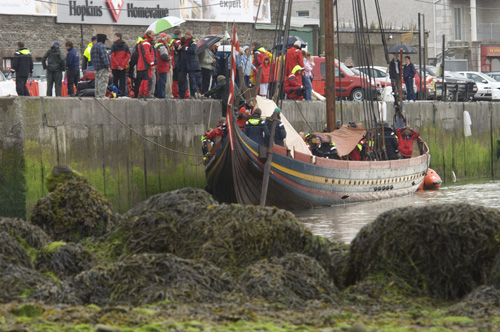The tides follow the Moon’s rotation around the earth. The gravitational pull of the Moon (and of the Sun) and the earth’s centrifugal force pull the water and give high and low tides approx. twice a day. The position of the Sun, Moon and Earth in relation to each other determines how high the water rises and falls with flow and ebb and that affects the strength of the currents.
In the eastern part of Denmark where the Sea Stallion comes from, we have almost no tide, because the connection to the ocean is too narrow. This makes it easier to sail in these waters compared to the waters we have sailed with the Sea Stallion in the English Channel, the Irish Sea, and the waters around the north-west Scotland. When we came to the Orkneys last year, the first advice we got was: “It’s more important to take the tide into account than the wind. You must know the tides and use them when sailing”. We have tried to work with the tides on the whole voyage: leaving harbours with the tide and arriving in harbours with the tide. A couple of times we have experienced what happens if we do not go with the tidal current and end up fighting to get into harbour against the tide. But when you sail under sail, you cannot know precisely when you will arrive at a harbour. Sometimes we have anchored close to our goal simply because we had to wait for the tide to be either neutral or with us. Other times we have reefed the sail to reduce speed so as not to arrive too early at a passage that could not be passed if the tide was against us. We avoided Pentland Firth between Scotland and the Orkneys because the tide gives currents up to 12 knots, and off the isle of Mull in western Scotland, where the shape of the sea bottom makes the tide give powerful eddies, we experienced how these pulled the Sea Stallion from side to side. On the voyage from Ireland and round Lands End, the wind was no more than 12–13 metres/sec., but the swell came from all sides, affected by the wind from one side and the tide from another, making it unpleasant sailing for both ship and crew. At St Alban’s Head in southern England, we sailed close in to land because we had sun, fresh wind and the current with us. But in a short while the sea rose up and the ship was pulled sideways in the swell, tossed by the wind and sea.
The tides cause powerful eddies or “whirlpools” and high breaking swells or “overfalls” that can make sailing extraordinarily difficult. That is why they are marked on sea charts. We can read the strength and direction of the current in charts and tables. The landscape changes with flood and ebb tides. Large areas that look sailable at high tide can change completely within 6 hours. New landscapes appear when the water falls several metres.
People are affected by the tide. People in tidal areas who live from and on the sea have a natural relationship to the tides. Our Irish crew members think the tides mean as much for them as the seasons do for us.
The boats in the area are also affected by the tide. If they lie in areas where there is dry land at ebb tide, the bottom of the boat is constructed so it will not fall over. Boats with a high keel have supports out to the sides. If the boat has no real keel, it will sink down in the sea bottom until the boats planks are broad enough to support the boat. The nature of the sea bottom is decisive for whether you can let the boats stand on the dry land. Most often they stand in gravel or sand.
Unfortunately, we had no chance to let the Sea Stallion stand on dry land. Our priority has been going into harbours and explaining the project, and sailing when possible.
The question is: Could the Sea Stallion stand dry on its keel with its 19 tons, including cargo and ballast, with being damaged? Can the ship stand on its keel without falling over so that it would not right itself when the water returned? Does it need supports to stay upright? Could the oars be used for this purpose?
Skuldelev 2 was built for these waters in the year 1042. About 25 years after the ship was built, the keel boards were repaired. The old keel boards were cut in half and new keel boards were clinched and spiked on the old keel. The repair was carried out in Ireland, England or Wales. We can see all this on the original ship, and the reason for the repair seems quite clear now when we sail around in tidal waters. Skuldelev 2 probably switched between floating at anchor and standing dry with the keel and keel boards sunk in gravel and sand, from which the damage to its keel arose.
We must away again and carry out new experiments…
